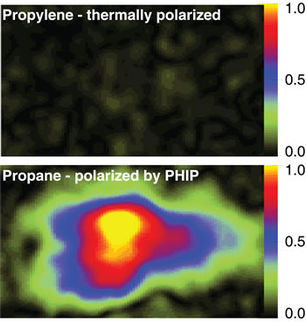How dangerous are gases from ship containers for consumers?
A BfR expert meeting is to examine the available data and identify research needs.
Ship containers are frequently treated with gas to combat pests. Dock workers who open the containers, warehouse workers who repack the goods and consumers who then purchase these goods, may be exposed to gas residues. In recent years minor health impairments linked to the opening of gas containers were reported to the Federal Institute for Risk Assessment. Measurements of the air inside the containers revealed, in some cases, high concentrations of fumigants and other volatile chemicals. "This raises the question whether the levels of residues of fumigants and other chemicals could be so high in the transported goods that they could impair the health of consumers", says Professor Dr. Dr. Andreas Hensel, President of BfR. Scientists at the Institute hope to obtain initial answers at today’s expert meeting at BfR in Berlin.
Measurements taken in the ports of Hamburg and Rotterdam revealed that the air in many containers contains higher concentrations of chemicals than are admissible according to the guidance values of occupational health and safety. These are not just residues of fumigants but also of other chemicals which are released during transport from the consumer goods or packaging materials.
Fumigated containers must be transported as "hazardous goods" in accordance with the internationally valid provisions on the marine transport of hazardous goods. This means that they must be labelled, that the ship management must be informed about the transport and that various provisions on the handling of the containers must be complied with. Random samples collected in the United Kingdom and the Netherlands seem to indicate that, despite this, many fumigated containers are transported which have not been correspondingly labelled as hazardous goods. It may also be the case that fumigated containers in Germany are not correctly labelled either.
BfR records cases of intoxications with chemicals from working and private life. Since the year 2000 there have been 71 cases reported with signs of health impairment after the opening of fumigated containers although the actual number is probably far higher. The people affected were individuals who had entered or who had been standing close to the opened containers.
In individual cases, Dutch examinations of foods transported in fumigated containers revealed that the maximum residue levels for fumigants had been exceeded. In one case the contamination was so high that it was reported to the European Rapid Alert System for Food and Feed, (RASFF). In the case of some samples, examinations also focused on how long products like textiles or furniture, which had been transported in import containers, continued to release fumigants and other chemicals. Mostly after just a few hours the chemicals could no longer be detected. In individual cases however, they could still be measured after weeks and months. So far it could not be determined scientifically whether the measured concentrations are so high that they could impair consumer health.
In order to obtain an overview about the available data and to be in a better position to assess the potential health risks for consumers from container gases, BfR is staging an expert meeting in Berlin today. Around 50 participants from universities, analytical institutions and public authorities have come together to discuss the test results from goods samples, assessments of health risks for consumers, intoxication notifications, international hazardous goods regulations and practical experience with these provisions. Research needs will be defined to tackle the open questions. The results of the expert meeting will be posted on the BfR website.
Most read news
Topics
Organizations
Other news from the department science

Get the analytics and lab tech industry in your inbox
By submitting this form you agree that LUMITOS AG will send you the newsletter(s) selected above by email. Your data will not be passed on to third parties. Your data will be stored and processed in accordance with our data protection regulations. LUMITOS may contact you by email for the purpose of advertising or market and opinion surveys. You can revoke your consent at any time without giving reasons to LUMITOS AG, Ernst-Augustin-Str. 2, 12489 Berlin, Germany or by e-mail at revoke@lumitos.com with effect for the future. In addition, each email contains a link to unsubscribe from the corresponding newsletter.


























































